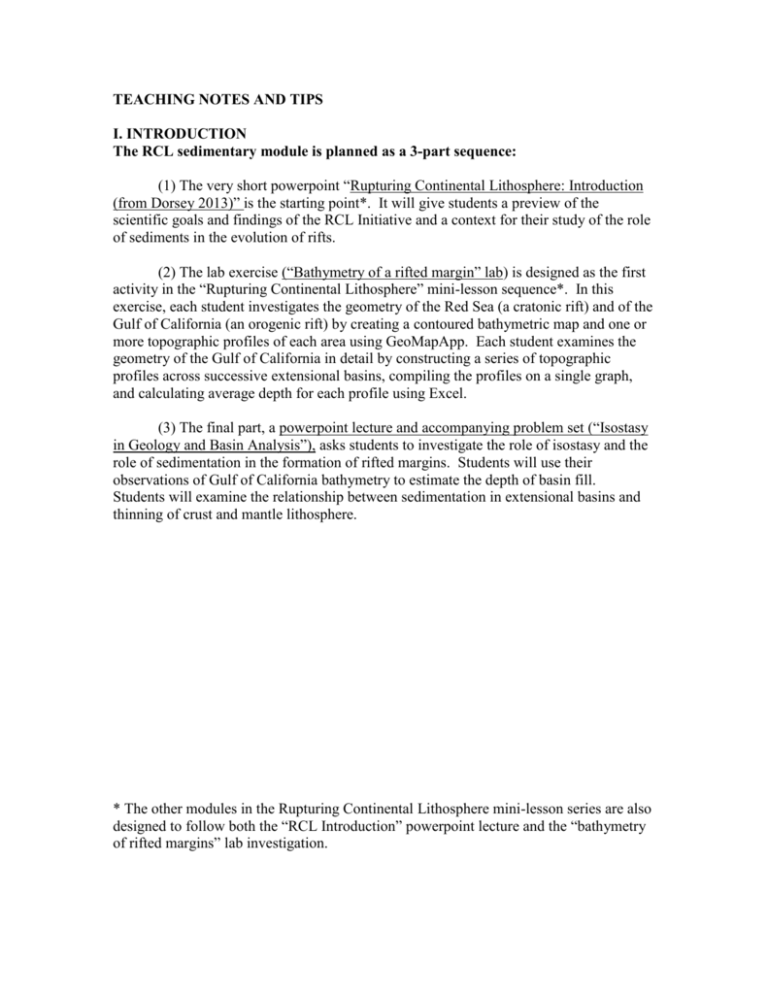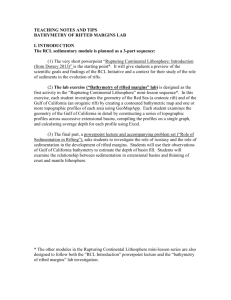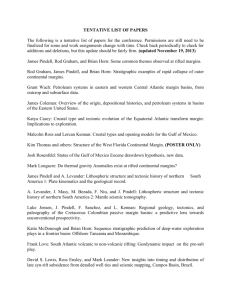Notes to instructor, "Role of Sedimentation"
advertisement

TEACHING NOTES AND TIPS I. INTRODUCTION The RCL sedimentary module is planned as a 3-part sequence: (1) The very short powerpoint “Rupturing Continental Lithosphere: Introduction (from Dorsey 2013)” is the starting point*. It will give students a preview of the scientific goals and findings of the RCL Initiative and a context for their study of the role of sediments in the evolution of rifts. (2) The lab exercise (“Bathymetry of a rifted margin” lab) is designed as the first activity in the “Rupturing Continental Lithosphere” mini-lesson sequence*. In this exercise, each student investigates the geometry of the Red Sea (a cratonic rift) and of the Gulf of California (an orogenic rift) by creating a contoured bathymetric map and one or more topographic profiles of each area using GeoMapApp. Each student examines the geometry of the Gulf of California in detail by constructing a series of topographic profiles across successive extensional basins, compiling the profiles on a single graph, and calculating average depth for each profile using Excel. (3) The final part, a powerpoint lecture and accompanying problem set (“Isostasy in Geology and Basin Analysis”), asks students to investigate the role of isostasy and the role of sedimentation in the formation of rifted margins. Students will use their observations of Gulf of California bathymetry to estimate the depth of basin fill. Students will examine the relationship between sedimentation in extensional basins and thinning of crust and mantle lithosphere. * The other modules in the Rupturing Continental Lithosphere mini-lesson series are also designed to follow both the “RCL Introduction” powerpoint lecture and the “bathymetry of rifted margins” lab investigation. II. BATHYMETRY OF RIFTED MARGINS LAB Prerequisite knowledge (students) 1) Basic understanding of plate motion at spreading centers (i.e. plate motion is parallel to transform faults, and is not required to be perpendicular to the spreading ridge). 2) Familiarity with Excel. Step-by-step instructions for compiling, analyzing and plotting measurements are included as an appendix, but some prior experience using Excel is very useful. Description of lab exercise The “Bathymetry of Rifted Margins” lab begins with an introduction to the morphology, relative plate motions, and bathymetry of the Red Sea rift. Students will use GeoMapApp to create a topographic and bathymetric contour map, and to draw a bathymetric profile across the Red Sea. Students are asked to work in pairs with each partner creating his/her own map and bathymetric profile, and to describe the morphology of the Red Sea rift based on similarities and differences between the bathymetric profiles drawn by both partners. Step-by-step instructions for using GeoMapApp are given in an Appendix. The main part of the “Bathymetry of Rifted Margins” lab is a more detailed study of the morphology, relative plate motions, and bathymetry of the Salton Trough – Gulf of California region. Each student will work with a partner to identify transform faults, interpret relative plate motion direction, and draw bathymetric profiles across a half dozen different sedimentary basins in the Salton Trough and Gulf of California (partners need not study all of the same basins). Students are asked to compile and analyze data by importing their bathymetric profiles into Excel, plotting all profiles on a single graph, and calculating average depth of each basin. Step-by-step instructions for using Excel are given in an Appendix. At the conclusion of the lab, students are asked to discuss northto-south changes in the shape and depth of Gulf of California basins, and to propose a hypothesis to explain the observed variation. Tips for instructor 1) The layout of this lab exercise places all of the specific instructions for how to use GeoMapApp in an appendix. Consequently, students will have to keep going to this appendix to get instructions for the next step. This layout is intended to separate the basic concepts and thought questions from the “nuts and bolts” instructions. Some instructors may choose to let students practice using GeoMapApp before the lab or at the beginning of the lab (for example, do the Red Sea profiles in class, as a group) to help students pick up basic GeoMapApp skills before undertaking the main lab activity, the Gulf of California profiles. Other instructors may chose to restructure the lab hand-out by moving instructions from the appendix into the text. 2) Student selection of lines for their bathymetric profiles is critical. It is essential for students to identify the opening direction correctly, and to choose profiles that are perpendicular to the opening direction for each basin. The instructor may decide to define assigned profiles in advance, both to avoid errors in profile orientation and to simplify comparison of students’ answers. Or the instructor may choose to lead students through the first profile or two as a group, to make sure they have the right idea before allowing them to proceed independently with the rest of the lab. 3) Students should answer the questions as they work through the lab (i.e. think about their results as they go along). 4) Make this a fully in-class exercise, so students interact with the instructor and with each other. Follow through in class to make sure students grasp the key principles: opening/extension direction vs. plate boundary; continental crust vs. oceanic crust and influence on bathymetry; sediment thickness variation. Students interpret, with one-onone guidance, and then review as a group and compare to classmates’ interpretations and to published interpretations. Allow individual write-ups so students can demonstrate their comprehension. III. ISOSTASY AND BASIN ANALYSIS ACTIVITY (POWERPOINT LECTURE AND PROBLEM SET) Prerequisite knowledge (students) Familiarity with the main features of rift basins and rifted margins (transition between continental crust and oceanic crust, nature and geometry of faults, factors that may influence rift basin processes and morphology). Description of activity The “Isostasy in Basin Analysis” activity is designed to follow the “Bathymetry of a Rifted Margins” lab. Students will use water depth measurements from their bathymetry spreadsheets for one of the calculations. If students did not do the bathymetric profiles exercise, they could use GoogleEarth to find the maximum depth of the Alarcon basin before starting this exercise. The “Isostasy in Basin Analysis” activity consists of a powerpoint lecture with an embedded set of problems for students to solve. The problems are worked out, and the answers are included on slides in the powerpoint presentation. (Answer slides have a gray background, in contrast to the blue background used for other slides.) The activity could be done either by the class as a whole, or by groups of students who work together on the problems and compare results before the answer slide is shown. The sequence of isostasy problems progresses from estimating the thickness of the lithosphere, to investigating the isostatic effect of filling a basin with water or with sediment (the Alarcon Basin is used as an example), to examining how crustal thinning affects the depth of sedimentary basins. In the final part of the exercise, students are given a cross-section of the Upper Delfin Basin, and are asked to calculate what rifting parameters (starting thickness of crust, starting thickness of mantle lithosphere, density of sediment fill) could produce the observed crustal structure. The first three experiments in this final section use different possible values for the starting thickness of mantle lithosphere; this value is important but is not well known. In the fourth experiment, students will use a new (higher) value for the average density of sediments filling the basin; average density would increase with increasing thickness of sediments. Students will need copies of the Upper Delfin basin cross-section by Martin-Barajas, in press, (there is a copy in the powerpoint lecture) to determine thickness values to use in the final part of the exercise. The file “Problem 4.1, 4.2, 4.3, 4.4 calculations.xlsx” is the excel spreadsheet that we (Dorsey and Cashman) used to solve for parameters that could produce the crustal structure of the Upper Delfin basin. If, instead of (or in addition to) the 4 experimental conditions suggested in the problems, students were given the more open-ended assignment of finding one or more sets of initial thicknesses and densities that could produce the observed structure of the basin, this spreadsheet provides a way for the instructor to check many different possible answers easily. Tips for instructor 1) Make this a fully in-class exercise, so students interact with the instructor and with each other. Follow through in class to make sure students grasp the key principles: role of isostasy in basin development; sediments are not just a passive record of basin history but exert direct control on rift processes and crustal composition. 2) Encourage students to identify the assumptions made and to identify the next step in problem-solving.







